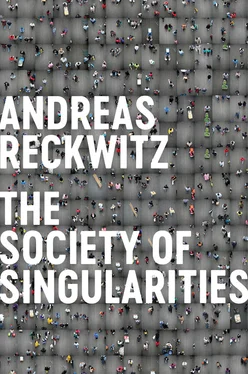2 The Social Logic of the Particular
At first glance, the idea of a social logic of singularities may seem oxymoronic. Is not the social, after all, the natural counterpart of the particular? Is it not the déformation professionnelle of sociology to focus exclusively on crowds and collectives, rules and schemata? At its heart, that is, is sociology not a science devoted to the social logic of the general? 1It is certainly no coincidence that sociology emerged as a discipline during the age of industrial modernity, and it still carries around a great deal of conceptual baggage from that time. Therefore, it might not seem well equipped to analyze processes of singularization – a problematic shortcoming if the goal is to understand late-modern society, which is organized around these very processes. In order to investigate the latter in a sociological and yet appropriate manner, it is necessary from the beginning to set aside the idea that sociality and singularity are fundamentally incompatible with one another. In fact, I would like to oppose this idea in decisive terms. In the case of singularities, it is not a matter of individual “vestiges” that remain behind after the social has withdrawn, or some sort of antithesis that battles against the social. Rather, if we remain open and curious about the interrelations and entities that assemble “the social,” it will be possible to view and analyze the logic of singularities, too, as a genuinely social logic.
What do I mean by singularities? In the history of concepts, the term “singularity” is relatively unladen; indeed, it is almost a neologism. 2Yet it seems necessary to employ a little-used term in order to focus on the realm of phenomena that it designates without introducing any false presumptions. It encompasses a broad semantic field of related concepts: the particular and the special, the unusual and the extraordinary, individuality and the individual, the “other” and the peculiar, the unique and idiosyncratic, originality and the original, the exceptional and the exclusive. My concern here is not to relate a detailed conceptual history but rather to focus on the matter itself: the social logic of the particular, which has been central to the existence of late-modern societies.
The General-Particular, Idiosyncrasies, Singularities
In order to understand singularities, it is first necessary to draw a precise distinction between three different forms of the particular: the general-particular , the idiosyncratic , and the singular .
Here it is apt to begin with Kant’s epistemological distinction between the general and the particular. 3In relating to the world, one invariably deals with general concepts. Even before the rise of formal rationalization, a social logic of the general existed in the form of implicit types. At the same time, however, we always take notice of particularities: the individual person, the individual thing, the individual place. Seen in this way, the particular is nothing special, and indeed ubiquitous. This raises the question of the relation between the general and the particular, and it is easy to conclude that practices in the typifying mode classify the particular with the help of the general and categorize it as an example of a general concept. This chair is a chair , this person is a mailman , and so on. In this context, the particular is thus nothing more than a concrete example of something general. Or one could also say that it is the general-particular . As the general-particular, the particular implies concrete exemplars that exist within the social logic of the general; it implies variations and versions of what is essentially the same – things, that is, of the same type .
The general-particular is not only an object in the observed world (as it is according to Kant); it is also an object of social production, appropriation, and evaluation of the world. From a sociological perspective, the general-particular is especially interesting when complex social orders of the general are formed in which fixed or variable positions are created for particular cases and differences, so that the particular is made to fit into the general. As we have already seen, precisely such an approach is characteristic of the processes of formal rationalization. Examples include universal legal systems, which make it possible to subsume individual legal cases under predetermined categories, and the classification of achievement in the form of school grades. In this sense, a society dominated by formal rationalization also generates particularities to a considerable extent. Yet here it is always a matter of the general-particular, which is always created and understood within the framework of the processes of standardization, generalization, and formalization discussed above. The general-particular thus exists in unambiguous rankings of qualitative differences (school grades, for instance) and in scales of quantitative differences (quantitative measurements of various sorts).
The general-particular should not be confused with what I would like to call idiosyncrasies . Here one can begin again with the difference between the general and the particular and maintain that idiosyncrasies are aspects of entities that cannot be made to fit into the concepts or schemata of the general: residual, idiosyncratic characteristics. This could be a feature of a given chair that goes beyond the idea of chairs as a general type – for instance, the specific wear and tear that it has suffered in a particular household over the years, or the memory that one’s grandmother once used to sit in it. Viewed in this way, idiosyncrasies are peculiar features that not only do not fit into the general but also oppose the orders of the general-particular.
Such a defensive understanding of idiosyncrasies, which presumes the primacy of the general, can be converted into a bold understanding. In bolder terms, one could say that all of the world’s entities exist initially as idiosyncrasies. 4They are special; they are unique to the extent that, in principle, they remain incommensurable with other entities. Nothing is identical with anything else; no entity can be converted into another without losing some quality. In this sense, every person is idiosyncratic, as is every plant, animal, or element of inorganic nature, not to mention every house or tool, every image and text, every location, every memory, every collective, and every belief. Thus understood, peculiarities are not the result of intentional design or the object of conscious appreciation or rejection; rather, as multiplicities, they are simply there – either independent of the existence of human beings (stones, animals, the cosmos, etc.) or as unintended side-effects of human activity (that is, as side-effects of the social). Regardless of whether idiosyncrasies are interpreted defensively or boldly, what is crucial is that they are unique features existing outside of the orders of the general that are not perceived as anything special by the social sphere itself. As unique features “in themselves,” they are marginal cases both for the social world and for the (social) sciences. Though ubiquitous, they are nearly invisible.
What I mean by the social logic of singularities is neither the system of the general-particular nor idiosyncrasies. In a certain way, singularities exist between the two. Whereas, in the general-particular, the relatively particular reproduces the order of the general, and whereas idiosyncrasies operate beyond and before all forms of socio-cultural communicability, singularities function within the socio-cultural order and yet are not limited to reproducing the logic of the general. In the case of singularities, we are dealing with entities that are perceived, evaluated, fabricated, and treated as unique within social practices. Singularities are the result of socio-cultural processes of singularization . They come into their own within a social logic of the particular. In such a logic, objects, subjects, spaces, temporalities, and collectives are turned into singularities through practices of observation, evaluation, production, and appropriation. Singularity, in other words, is enacted . 5
Читать дальше












